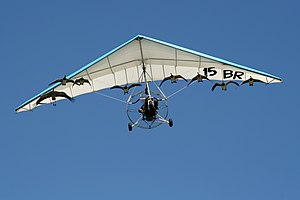Imprinting (psychology)
In psychology and ethology, imprinting is any kind of phase-sensitive learning (learning occurring at a particular age or a particular life stage) that is rapid and apparently independent of the consequences of behaviour. It was first used to describe situations in which an animal or person learns the characteristics of some stimulus, which is therefore said to be "imprinted" onto the subject. Imprinting is hypothesized to have a critical period.
Filial imprinting
The best-known form of imprinting is filial imprinting, in which a young animal narrows its social preferences to an object (typically a parent) as a result of exposure to that object. It is most obvious in
Lorenz demonstrated how incubator-hatched geese would imprint on the first suitable moving stimulus they saw within what he called a "
The filial imprinting of birds was a primary technique used to create the movie

The Italian
In a similar project, orphaned
Chicks of domestic chickens prefer to be near large groups of objects that they have imprinted on. This behaviour was used to determine that very young chicks of a few days old have rudimentary counting skills. In a series of experiments, they were made to imprint on plastic balls and could figure out which of two groups of balls hidden behind screens had the most balls.[4]
American coot mothers have the ability to recognize their chicks by imprinting on cues from the first chick that hatches. This allows mothers to distinguish their chicks from parasitic chicks.
The peregrine falcon has also been known to imprint on specific structures for their breeding grounds such as cliff sides and bridges and thus will favour that location for breeding.[5][6]
Sexual imprinting
Sexual imprinting is the process by which a young animal learns the characteristics of a desirable mate. For example, male zebra finches appear to prefer mates with the appearance of the female bird that rears them.[7]
Sexual attraction to humans can develop in non-human mammals or birds as a result of sexual imprinting when reared from young by humans. One example is London Zoo female giant panda Chi Chi. When taken to Moscow Zoo for mating with the male giant panda An An, she refused his attempts to mate with her, but made a full sexual self-presentation to a zookeeper.[8][9]
It commonly occurs in
Sexual imprinting on inanimate objects is a popular theory concerning the development of sexual fetishism.[12] For example, according to this theory, imprinting on shoes or boots (as with Konrad Lorenz's geese) would be the cause of shoe fetishism.[citation needed]
Limbic imprinting
Some suggest that prenatal, perinatal and post-natal experiences leave imprints upon the limbic system, causing lifelong effects and this process is identified as limbic imprinting.[13] The term is also described as the human emotional map, deep-seated beliefs, and values that are stored in the brain's limbic system and govern people's lives at the subconscious level.[14] It is one of the suggested explanations for the claim that the experiences of an infant, particularly during the first two years of life, contribute to a person's lifelong psychological development.[15] Imprinted genes can have astounding effects on body size, brain size, and the process in which the brain organizes its processes. Evolutionary trends within the animal kingdom have been shown to show substantive increase in the forebrain particularly towards the limbic system. This evolution has even been thought of to have a mutative effect on the brain size trickling down the human ancestry.[16]
Westermarck effect
Reverse sexual imprinting is also seen in instances where two people who live in domestic proximity during the first few years in the life of either one become desensitized to later close
In the case of the Israeli kibbutzim (collective farms), children were reared somewhat communally in peer groups, based on age, not biological relation. A study of the marriage patterns of these children later in life revealed that out of the nearly 3,000 marriages that occurred across the kibbutz system, only fourteen were between children from the same peer group. Of those fourteen, none had been reared together during the first six years of life. This result provides evidence not only that the Westermarck effect is demonstrable but that it operates during the period from birth to the age of six.[17] However, Eran Shor and Dalit Simchai claimed that the case of the kibbutzim actually provides little support for the Westermarck effect.[18]
When proximity during this
Baby duck syndrome

In human–computer interaction, baby duck syndrome denotes the tendency for computer users to "imprint" on the first system they learn, then judge other systems by their similarity to that first system. The result is that "users generally prefer systems similar to those they learned on and dislike unfamiliar systems".[22] The issue may present itself relatively early in a computer user's experience, and it has been observed to impede education of students in new software systems or user interfaces.[23]
See also
- Ivan Pavlov
- Kin recognition
- Kin selection
- Attachment theory
- Imprinting (organizational theory)
- Psychical inertia
References
- ^ Harding, Naomi (June 13, 2016). "How does animal imprinting work?". animalanswers.co.uk. Archived from the original on October 12, 2016.
- ^ a b T. L. Brink. (2008) Psychology: A Student Friendly Approach. "Unit 12: Developmental Psychology." pp. 268
- ^ a b Davidson, Phil (March 31, 2006). "Angelo d'Arrigo". The Guardian.
- PMID 19364746.
- ^ Devine, Ann (1994–2013). "Peregrine Falcon Dispersal and Habitat Imprinting" (PDF). p. 20. Retrieved 24 January 2018 – via Natural Resources and Environmental Sciences Online Program.
- PMID 36011398.
- ISSN 0065-3454.
- ISBN 978-1-4532-1773-3
- Baltimore Sun
- ^ "Modern Captive Breeding–Part II – Falconry related information, laws, supplies for sale". falconers.com. Archived from the original on April 24, 2017.
- ^ "Behold the falcon sex hat, a species-saving hump helmet". Earth Touch News Network. Retrieved 2019-08-21.
- PMID 15500813. Retrieved October 2, 2003.
- ISBN 9781402091674.
- ISBN 9781615990870.
- ISBN 9780393709179.
- S2CID 5542058.
- LCCN 81006552.
- S2CID 27854996.
- ISBN 9788120345195.
- ^ Freud, S. (1913) Totem and Taboo in The Standard edition of the Complete Psychological works of Sigmund Freud, Vol XIII
- ^ Steven Pinker, How the Mind Works.
- IBM DeveloperWorks, 2 March 2005
- ISBN 978-1-4020-7363-2.
Further reading
- Paul, Robert A. (1988). "Psychoanalysis and the Propinquity Theory of Incest Avoidance". Journal of Psychohistory. 15 (3): 255–261.
- Spain, David H. (1987). "The Westermarck–Freud Incest-Theory Debate: An Evaluation and Reformation". Current Anthropology. 28 (5): 623–635, 643–645. S2CID 145420633.
- Westermarck, Edvard A. (1921). The History of Human Marriage (5th ed.). London: Macmillan.
External links
- Cardoso, SH and Sabbatini, RME. Learning who is your mother. The behavior of imprinting. Brain & Mind Magazine.
- Nancy T. Burley, a researcher into imprinting in zebra finches
- Debra Lieberman, John Tooby and Leda Cosmides. "Does morality have a biological basis? An empirical test of the factors governing moral sentiments relating to incest." Accepted for publication in Proc. R. Soc. Lond. B November 2002. Available online at Citeseer
